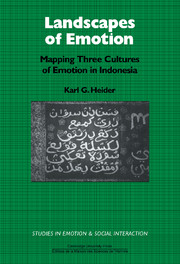Book contents
- Frontmatter
- Contents
- Acknowledgement
- PART I THEORY, METHOD, AND RESULTS
- 1 Theoretical introduction
- 2 Mapping the realm of emotion
- 3 Membership in the realm of emotion: prototypicality
- 4 Emotion scenarios: antecedents and outcomes
- 5 Comparisons between languages
- 6 The composite maps of emotion terms, cluster by cluster
- 7 Conclusions
- PART II A CLUSTER-BY-CLUSTER ANALYSIS OF THE COMPOSITE MAPS OF EMOTION TERMS
- Bibliography
- Author index
- Subject index
2 - Mapping the realm of emotion
Published online by Cambridge University Press: 22 October 2009
- Frontmatter
- Contents
- Acknowledgement
- PART I THEORY, METHOD, AND RESULTS
- 1 Theoretical introduction
- 2 Mapping the realm of emotion
- 3 Membership in the realm of emotion: prototypicality
- 4 Emotion scenarios: antecedents and outcomes
- 5 Comparisons between languages
- 6 The composite maps of emotion terms, cluster by cluster
- 7 Conclusions
- PART II A CLUSTER-BY-CLUSTER ANALYSIS OF THE COMPOSITE MAPS OF EMOTION TERMS
- Bibliography
- Author index
- Subject index
Summary
Procedure
Each of the three maps to be described here represents the way emotion terms in one language are interrelated. For those who want to know just how the maps were constructed, the following pages afford a somewhat detailed account of how I developed the procedure. Other readers might want to proceed directly to Chapter 6, where the analysis of the maps begins.
My first step was to develop a master list of emotion words in Indonesian. (I started with Indonesian, rather than with Minangkabau, because it was easier to approach. At the beginning of the fieldwork I knew fair Indonesian but no Minangkabau, and there are better dictionaries for Indonesian than for Minangkabau.)
Between my own knowledge of Indonesian, various dictionaries, and some Indonesian novels written by Minangkabau, I developed a list of thirty-eight words that were the most obvious emotion words. For each of these Indonesian starter words, bilingual Minangkabau were asked to give synonyms in Indonesian and translation equivalents in Minangkabau. I worked over the results, making preliminary maps of clusterings and expanding the lists. I also began a master list of Minangkabau words.
At the beginning of the second year of fieldwork I reworked the master lists, expanding them to 189 words in Indonesian and 197 words in Minangkabau. At this point another research task became an important source of emotion words.
- Type
- Chapter
- Information
- Landscapes of EmotionMapping Three Cultures of Emotion in Indonesia, pp. 24 - 40Publisher: Cambridge University PressPrint publication year: 1991



